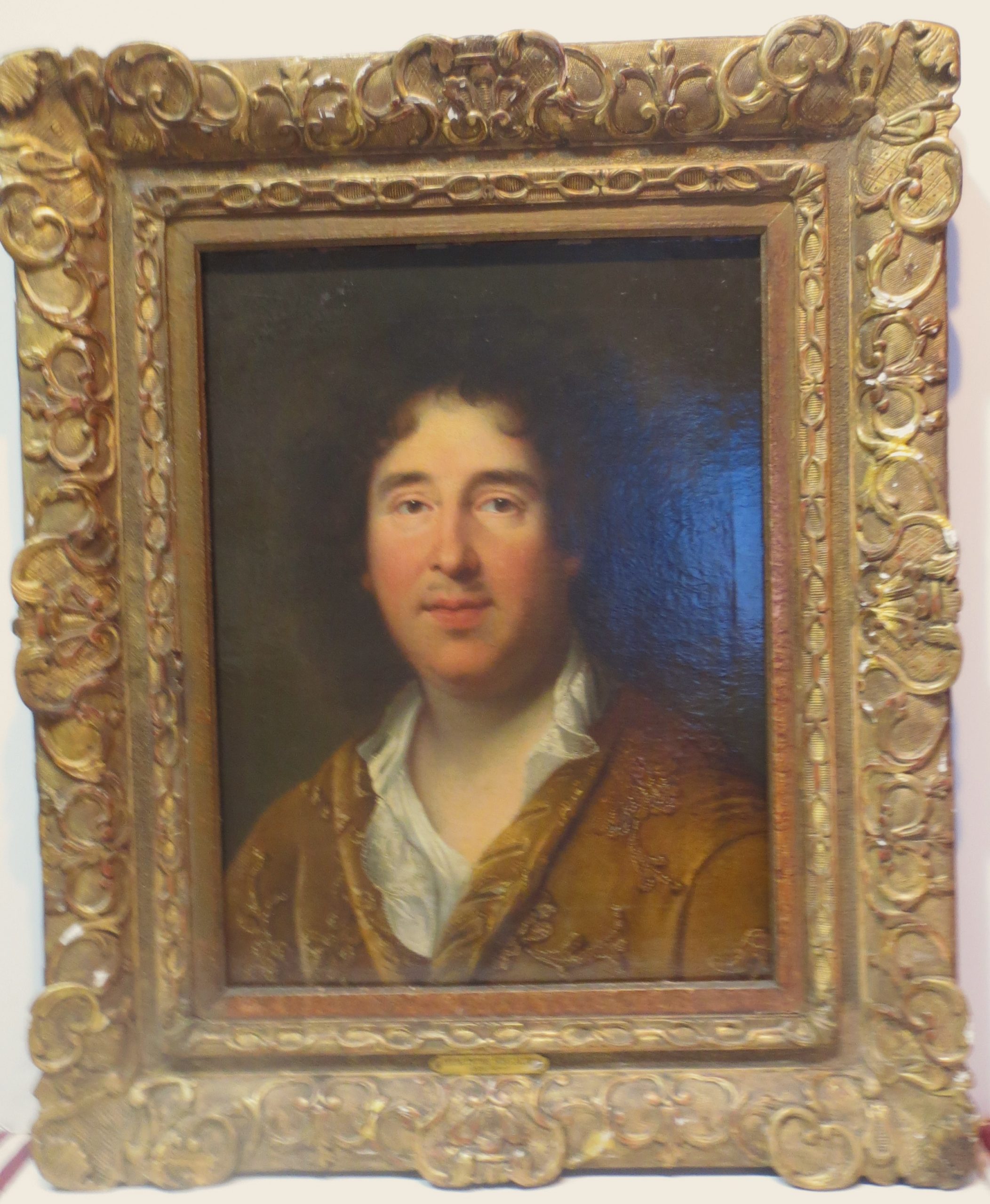Of a type familiar from Largilliere’s portraits of fellow artists, bare headed in atelier dress or open blouse and loose smock, robe or sitting coat, color and handling of this portrait show the same quick and fluid touch in the hair, smoother half-tone blends in the modeling of facial forms, eyes and highlights, and a bravura certitude of fast pulled strokes of thicker paint in rendering the drapery, all collectively suggestive of a date late in the seventeenth century. This portrait shows the same casually garbed figure seen on the left side of Largilliere’s painting of the virtuoso engraver Gérard Edelinck (The Artist in his Studio, Chrysler Museum of Art, Norfolk, VA) with a third figure to the right, sometimes thought to be Largilliere himself), the unidentified man standing on the left, sometimes identified as the patron Pierre Bernard but not really dressed in suitable mercantile attire and more likely to be another artist.

The tangled debate about these identities have been well explicated by Myra Nan Rosenfeld, first in the exhibition catalogue Largillière and the Eighteenth-Century Portrait, Montreal (Museum of Fine Arts),1981, No.45, pp. 227-230, and then in Largilliere 1656-1746, Paris (Musée Jacquemart-André, 2004-2005, No. 14, pp. 90, with subsequent literature. Relatable portraits of artists are illustrated inter alia in the Montreal catalogue as Nos. 46 and 48, while brusquer brushwork is already seen earlier in the portrait of the Comte de Maglalotti (illustrated and dated 1692-1693 as No. 3 in the Paris catalogue).
The previously unpublished portrait introduced here invites a fresh consideration of the identity of a sitter who may well have been the man on the left side of the Edelinck group. They seem to be of the same age, alike in coloring and general appearance, even to the curls of dark hair framing their forehead. Their features are equally comparable: both have distinctly heavy eyebrows, low lidded eyes, and full lower lips. Both faces sport identical wisps of mustache wings separated by a wide philtrum just below the nose. Sans wig and cravat, each wears a loosely joined robe over a blouse open from throat to sternum and upper chest, again indicative of an artistic rather than a fiscal cast.
Once considered as an artist, a more focused clue to his identity can be gathered from the action of his right arm and hand. He stands close to the corner of a table on which a statuette sits just inches ahead of his outstretched arm, open hand and pointing fingers. It is a gesture inviting and focusing attention to the statue, in a clear space of its own more likely as the focal of his gesture than the painting well behind his back, near lost in enveloping umbra. This dark obscurity was once adduced as a signal of Bernard’s interest as a patron. The near object of an openly indicative gesture, the statuette, went unnoted in favor of extrapolating a connection with Bernard from the almost invisible painting in the background. It seems more likely on all accounts that like cast attire, the statuette is a primary sesame in this conundrum,
The statuette measured by relationship to hands and feet in the painting would come to about forty centimeters (sixteen inches) in height in a basic contrapposto pose: arched torso resting on the straight right leg, left leg bent back at the knee, and right arm akimbo with fist on hip, a common gesture of arrogance. Ultimately, the statuette reflects the widely known and frequently appropriated Praxitelean figure of Hermes of Andros (aka Mercury; Vatican, Belvedere), who was often conflated with Antinous and several other heroic male representations well into the eighteenth century (cf. Phyllis P. Bober and Ruth O. Rubinstein, Renaissance Artists and Antique Sculpture, 2nded., London/Turnhout, 2010, No. 10, pp. 62-63.) Yet despite commonly serving as a generic heroic type, both in paintings, prints and as pseudo-antique marble souvenirs of the English Grand Tour, it was surprisingly rare in France under Louis XIV who had a lock on the creation of large scale á l’antique statues primarily destined for Versailles.
From 1685 until his death in 1705, Claude Bertin was in residence at Versailles with an appointment as ‘Sculptor in Ordinary to the King’ with an annual fee for a variety of responsibilities including the creation of giant urns and miscellaneous secondary statues, the maintenance of the entire assemblage and the modest foliation of the nudes. Both a skilled designer and restorer, Bertin’s extensive knowledge of both antique and contemporary sculpture is gathered from the range of the Versailles commissions and his own drawn studies for park statues intended for Versailles, Marly, Trianon, and Mendon. One study in particular converted a literal copy of the Praxiteles Hermes-Mercury type for a projected statue of Apollo while thirteen others drew on other antique prototypes for statues of gods and demi-gods including reclining personifications of the Nile, the Tiber, and the Seine inevitably meant to grace a fountain or pool. (For Bertin’s career, sculptural projects and his relevant drawings cf. François Souchal, French Sculptors of the 17th and 18th Centuries:The Reign of Louis XIV, Oxford, 1977, Vol. l, 38-47; for the drawing of Apollo and fourteen others of this ilk now in Berlin and related data, cf. Souchal, nos.12-20, pp. 43-44.
The statuette in the Edelinck group painting is quite close in form to the Bertin drawing of Apollo,

although alone among its kindred fourteen drawings it is not in a report of 1697 as the progenitor of a marble ‘statuette’ measuring about a meter in height, possibly intended for peripheral pavilion or balustrade ornaments or such, rather than a life size garden piece. The absence in the 1697 report of a ‘statuette’ after Bertin’s Apollo seems an odd lacuna in the systemic projection of Bertin’s drawings into three dimensional avatars, unless at an earlier stage in the development of this series a slightly smaller statuette had been prepared after the Apollo to serve for eventual acceptance and installation in scale in the heroic masculine guise of Mars, Meleager or Antinous. Indeed, the latter two were in fact created and installed at the entrance to the bosquet des rocailles as over life size marble that, albeit not executed by Bertin, certainly recalled his original design and statuette of the Hermes or Mercury. Then, too, he was the valued designer of many of the urns and ornamental busts in the bosquet water park and the artist charged with the invention and application of obfuscating fig leaves for those heroic male nudes whose features, if not figure, resembling Louis XIV.
In 1686 or 1687, when Largilliere began the Edelinck painting, he included as part of the larger studio theme his own likeness and that of a young sculptor who may well have been Claude Bertin. Although Bertin’s exact birth date is unknown, circumstance would place it just before or at 1660 making him old enough to be a teacher to his brother Nicolas Bertin, to have married and sired a daughter, Marguerite, who only reached the age of marriage in 1717, putting her probable date of birth to the end of the previous century, just years before her father’s death. Most indicative of all, the age and appearance of the young sculptor pointing out his statuette of a Hermes, Mercury or generally conflated Antinous, would match in age the young Bertin, then in his late twenties with recently accredited creative and administrative duties in the realization of Versailles. Including Bertin in Largilliere’s studio painting around the elder Edelinck would have been a discretely modest dual accolade for the young artist. Shown as the youngest of the gathering but with an emblematic reference to his skills as an antiquarian and sculptor in the retinue of Louis XIV, this also marks a social graduation to affiliation with both the venerable Edelinck and, with far greater relevance, shows him as a new member of the social and artistic elite celebrated more for talent than title alone.

